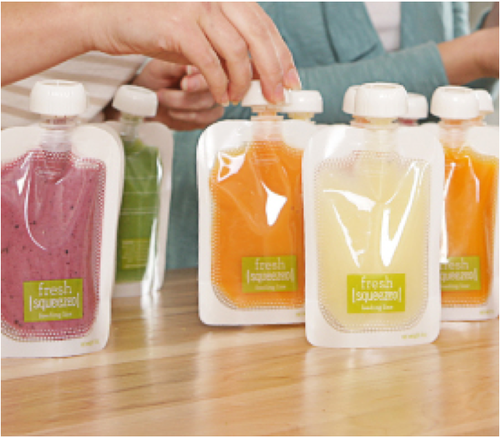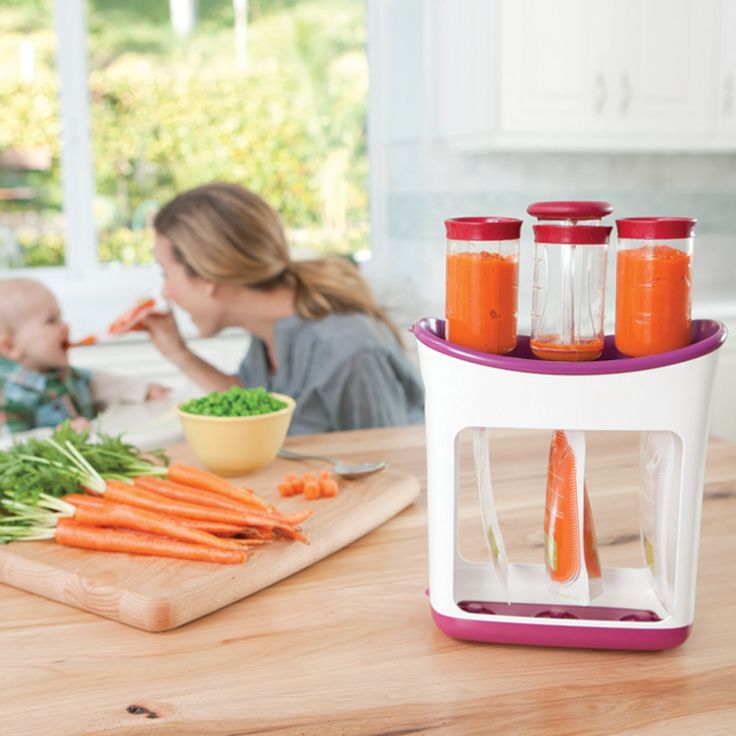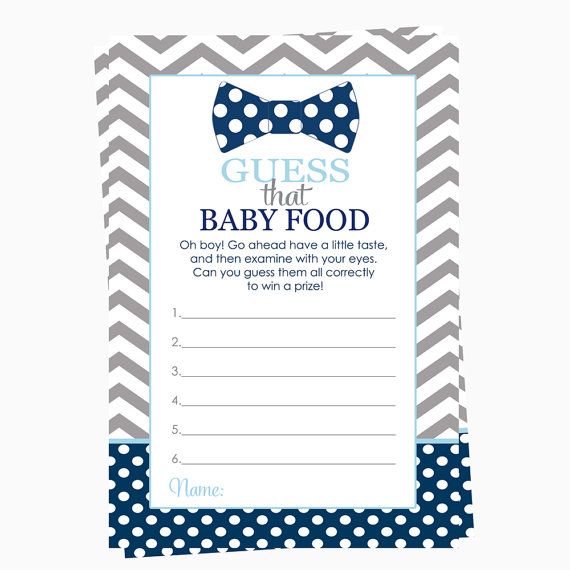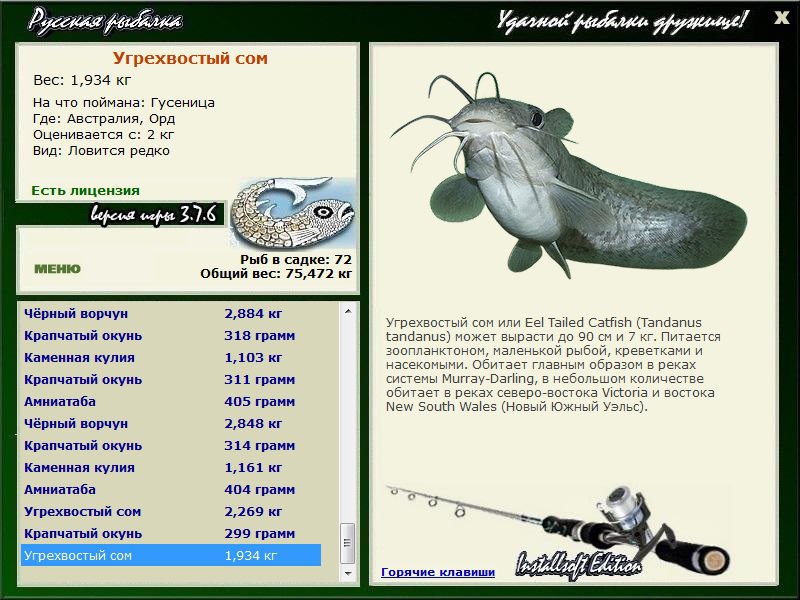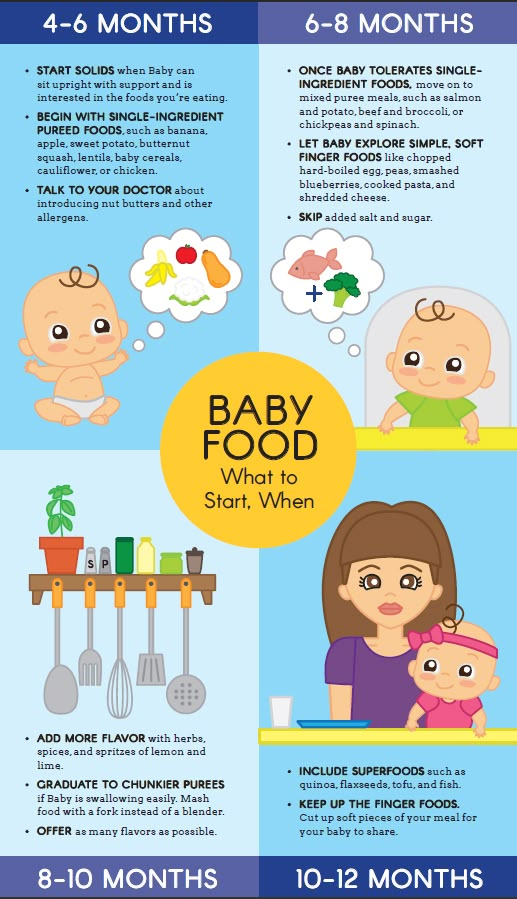First foods for baby schedule
Sample Schedules for Starting Solids (6 to 12 Months)
Looking for sample schedules for starting solids? Ideas for how to introduce solids on a schedule. Including sample feeding schedule for 6 months old and beyond.
Ready to start solids with your babe? This is an exciting time!
Here’s everything you need to know about introducing solids safely including sample schedules for starting solids from 6 months to 12 months, plus recommended menu items.
Is Baby Ready for Solids?
The most important thing to consider as your baby approaches the 4-6 month mark, is whether they are showing signs of feeding readiness.
This includes things like:
- Baby is 6 months old (there is no benefit to starting solids before 4 months at the earliest)
- They are interested in food they see around them
- Baby is losing their tongue thrust reflex that keeps food out of their mouth
- They are sitting up on their own for at least 60 seconds at a time
If your baby is showing these signs, great! It’s time to start introducing some solids.
Note that baby should continue receiving breast milk and/or formula for at least the first year of life, as you begin the transition to solid foods.
What Are the Benefits of Solids?
Eventually, your baby’s diet will be predominantly solid foods, but it takes some time to get there.
Solid foods expose your baby to a wide variety of textures, shapes, consistencies, and colors. They’re also important for nutrition, providing an array of vitamins, minerals, fiber, protein, fat, and energy.
Eating solids is also important for physical growth and development. As your baby matures, they become prepared to try new foods and get more of their nutrients from solids than breast milk/formula.
Plus, it’s fun to play with and try new foods!
However you decide to introduce solids – using a traditional spoon-feeding/puree approach or a baby-led weaning approach – your baby benefits from the nutrition and exposure.
Recommended Solid Foods for Babies
Below are some nutritious first foods that have worked well for us:
- Tofu
- Avocado
- Oatmeal
- Hummus
- Pancakes
- Soft fruits, like bananas, kiwi, mango
- Soft-cooked vegetables, like zucchini, sweet potato, and broccoli
- Beans, peas, lentils
- Toast, cut into strips
As you design your baby’s menu, these are some great nutrient-dense foods to incorporate that can also be prepared and served in an age-appropriate way.
For a list of foods to avoid when starting solids, see this blog post.
Sample Schedules for Starting Solids
How you choose to design your baby’s solid feeding schedule depends on several things, including what your daily routine looks like.
We recommend beginning with 1 solid food meal per day for 6-month-old babes and increasing to 3 meals per day for 9-month-old babies.
Between these milestones, continue to slowly add new foods and increase how many meals/snacks you’re offering.
By 12 months old, your baby will be eating 3 meals and a few snacks per day of solid foods, using breast milk and/or milk/milk alternatives (e.g., fortified unsweetened soy or pea milk) as needed.
Keep in mind that it can take 10-15 times of offering a food before a baby even tries it, or decides whether they like it. If your baby doesn’t seem to be interested in a certain food, keep offering.
Below are a few example feeding schedules for offering solids to babes at least 6 months old.
Feeding Schedule for 6 Months
- 7am: Breastfeed/bottle feed
- 8am: Breakfast – Iron-fortified baby oat cereal, peeled sliced peaches, avocado strips
- 11am: Breastfeed/bottle feed
- 2pm: Breastfeed/bottle feed
- 5pm: Breastfeed/bottle feed
- 7pm: Breastfeed/bottle feed
Note that you may continue to breastfeed/bottle feed babies this age during the night if they are still waking up.
Feeding Schedule for 9 Months
- 7am: Breastfeed/bottle feed
- 8am: Breakfast – Pancake strips, chopped raspberries and bananes
- 11am: Breastfeed/bottle feed
- 12pm: Lunch – Penne pasta with tomato sauce, green peas, melon slices with skin and seed removed
- 3pm: Breastfeed/bottle feed
- 5pm: Breastfeed/bottle feed
- 6pm: Dinner – Smashed black beans, tofu strips drizzled with thinned nut butter, sliced orange sections with outer membranes and pith removed
- 7pm: Breastfeed/bottle feed
Feeding Schedule for 12 Months
- 7am: Breast milk or milk/milk alternative
- 8am: Breakfast – Toast strips with mashed avocado, half of a banana (remove 2 inches of the skin, leaving the rest of the peel for easy handling)
- 10am: Mid-morning snack – chopped watermelon, diced grapes, hummus
- 12pm: Lunch – Quinoa-based veggie burger patty, steamed cauliflower and beet strips
- 3pm: Afternoon snack + breast milk or milk/milk alternative
- 6pm: Dinner – Lightly fried tempeh strips, kidney beans, roasted sweet potato cubes, steamed cucumber
- 7pm: Breast milk or milk/milk alternative
We hope these sample schedules for starting solids are helpful when your baby is ready for first foods.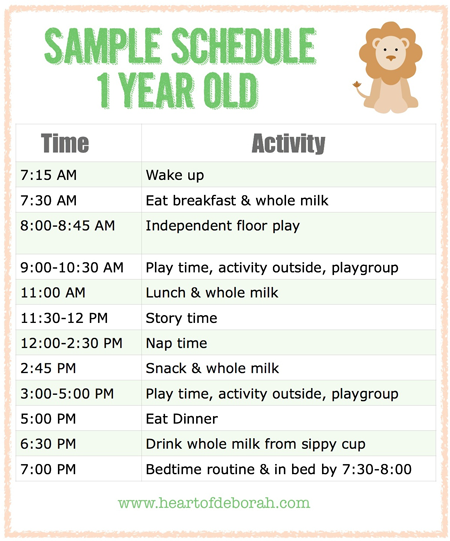 When you introduce solids on a schedule, this can help alleviate some of the stress of feeding while nourishing your baby well. Have fun with it!
When you introduce solids on a schedule, this can help alleviate some of the stress of feeding while nourishing your baby well. Have fun with it!
Chime In: If you’ve already done solids with your babe, what has your schedule looked like? Any other tips for new parents?
If you found this post helpful, we suggest you read these too:
- Spoon Feeding vs. Baby-Led Weaning
- Do Babies Really Need 11mg of Iron a Day?
- Plant-Based Baby-Led Weaning Grocery List
- How to Wean Baby to Plant-Based Milk
Homemade baby food introducing solids schedule
By Kathryn Doherty
This post may contain affiliate links. As an Amazon Associate I earn from qualifying purchases. Please read my disclosure policy
Homemade baby food introducing solids schedule is a guide on what foods to introduce to your baby at different stages. A great way for making sure they get plenty of variety!
Introducing solids to your little one — which just means supplementing the breast milk or formula they are getting with baby food purees — is an exciting and somewhat scary time.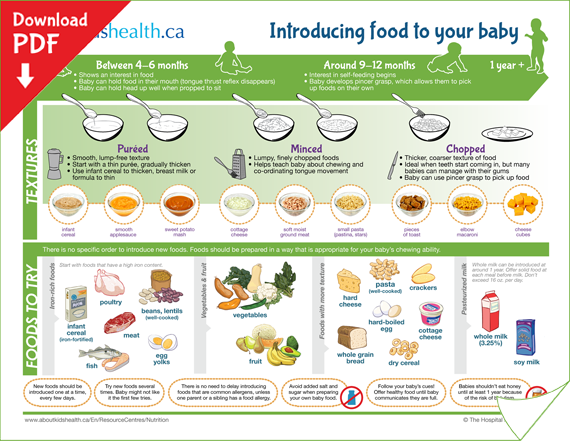 It can be intimidating to know what to do, when and how.
It can be intimidating to know what to do, when and how.
I’ve put together a lot of homemade baby food resources on this blog to help you through the process and to encourage you to make your own baby food. It’s so, so easy. I promise!
Update: I’ve also written a new cookbook all about making healthy, easy baby food! The Healthy, Quick & Easy Baby Food cookbook is available on Amazon and in most booksellers. It’s got all the info and resources you need to get started, plus 100 recipes ranging from single purees to combinations to finger foods and toddler meals. You’ll have everything you need in one place! (Also, it makes a great gift!)
Today though, I’ve created a homemade baby food introducing solids schedule for you to use as a guide to beginning this journey.
This list is what I researched and used when introducing baby food to M and I mostly stuck to the same thing with J. My kiddos loved purees and were not big on baby-led weaning, so this is the route I took.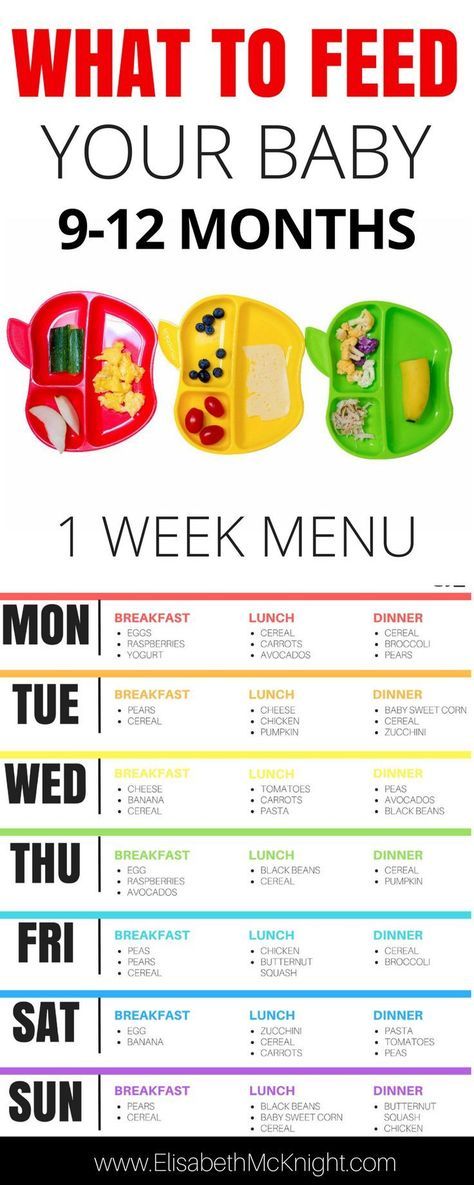
(And if you want to save that schedule above, I made a free printable PDF for you!)
- Currently, the recommendation is to introduce solids to a baby somewhere between 4 and 6 months old, depending on the child’s readiness. Talk to your pediatrician about when to introduce solids for your baby.
- Wait 3-5 days between introducing new foods, to monitor for an allergic reaction.
- Speaking of allergies, current research says it’s OK to introduce peanut products as early as 4-6 months old. (This is new since my kids were babies.) If you are concerned about a possible peanut allergy, please check with your health care provider before offering any type of peanut product to your baby.
- You can refrigerate homemade baby food for up to 3-5 days and freeze baby food for up to 6 months. Just be sure to label everything!
- Got extra? I’ve got tons of ideas and recipes (and a video and free printable, too) for ways to use leftover baby food.
- Check out my master list of homemade baby food resources for more info.

Also, if you are new to this journey, check out my guide on how to make homemade baby food purees. I walk you through ALL the ins and outs of making purees at home, including step-by-step instructions for 10 favorite beginner purees.
You can watch this video to see how easy it is to make your own baby food:
I hope this homemade baby food introducing solids schedule is helpful for you to get started! Here’s the FREE PRINTABLE again if you want to print this schedule out to save.
Oh, and if you have a fussy teething baby that’s 8 months or older, definitely check out these homemade baby teething biscuits.
And if you want to be super efficient in making baby purees, it’s all about the batch cooking.
Here are my collections of beginner homemade baby food batch cooking — lots of beginner baby food basics grouped together to make the most out of your precious time. You can knock out 5 foods in as little as 20 minutes!
These batch cooking guides will also give you step-by-step details on how exactly to prepare various foods for your baby.
Homemade baby food round 1: peas, green beans, applesauce, butternut squash, oatmeal
Homemade baby food round 2: sweet potato, brown rice, chicken, pears, banana
Homemade baby food round 3: quinoa, peaches, avocado, pumpkin, cottage cheese
Homemade baby food round 4: broccoli, zucchini, yellow squash, black beans, Greek yogurt
Homemade baby food round 5: asparagus, barley, edamame, blueberries, mango
Homemade baby food round 6: apricots, prunes, egg yolks, chick peas, blackberries
Lastly, have fun with it! It’s exciting to see your baby discover the joys of different food and flavors!
Enjoy and let me know if you have questions! Happy to try and help 😊
XO,
Kathryn
(P.S. Here’s the link for the free printable again!)
Breastfeeding first complementary feeding schedule
Complementary feeding during lactation is a small amount of food that is given to the baby in addition to mother's milk. Such food can be meat, cottage cheese, vegetables, fruits, cereals.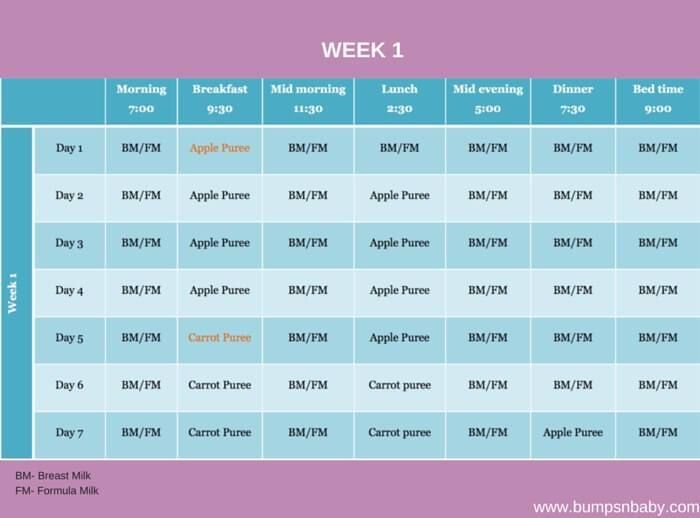 The question of what kind of first complementary foods to introduce to a child is relevant for inexperienced parents. When planning to supplement breastfeeding, it is important to consider the timeliness factor. If the baby’s nutrition is not expanded at the required time, he will suffer from a lack of weight, a deficiency of nutrients in the body. In this case, favorable conditions are created for weakening the immune system and the development of various diseases. A neonatologist or an observing pediatrician will help to draw up a scheme for the optimal introduction of complementary foods for the baby.
The question of what kind of first complementary foods to introduce to a child is relevant for inexperienced parents. When planning to supplement breastfeeding, it is important to consider the timeliness factor. If the baby’s nutrition is not expanded at the required time, he will suffer from a lack of weight, a deficiency of nutrients in the body. In this case, favorable conditions are created for weakening the immune system and the development of various diseases. A neonatologist or an observing pediatrician will help to draw up a scheme for the optimal introduction of complementary foods for the baby.
What is complementary foods and from what month is it usually introduced? The purpose of expanding the children's diet is to saturate the baby, create conditions for its full development.
Even at the consultation stage, neonatologists warn mothers about the age at which the first complementary foods are - on average, from six months. In many ways, this indicator depends on whether the baby was born full-term, whether he has chronic diseases, how he tolerates the use of mother's milk.
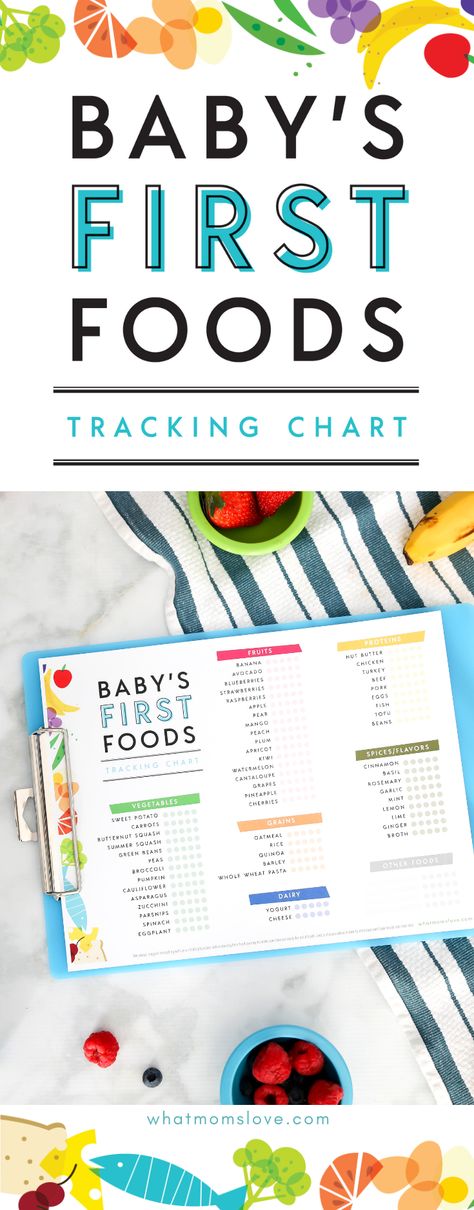 Only if there are special medical indications, the first complementary foods are prescribed at 4.5-5 months.
Only if there are special medical indications, the first complementary foods are prescribed at 4.5-5 months. Up to six months, the body of a newborn receives nutrients (vitamins, enzymes, minerals) during lactation. But as the baby grows and develops, its needs for useful components also increase. Supplement to mother's milk helps to meet the need of the child's body for magnesium, calcium, zinc, iron.
Experts emphasize not that the use of juice as a first complementary food is not entirely correct: it refers to corrective supplements, and not to nutrition. In addition, an attempt to supplement the children's menu with such a product leads to the development of diarrhea in the child, and a high concentration of sugar reduces appetite, and children consume less milk. Another reason why experts do not recommend starting complementary foods with juice is the high risk of developing diathesis. This is also due to the high content of glucose in the product.
There are 2 programs for the introduction of the first complementary foods.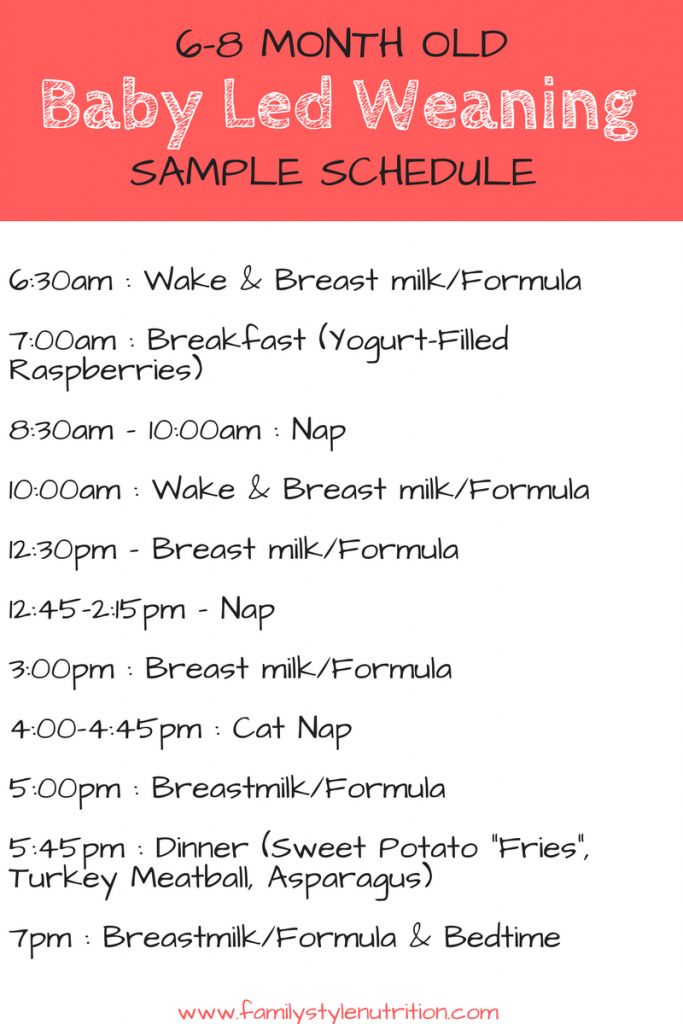 The first scheme involves supplementing the children's diet with fruits, the second - with cereals and vegetables. Mom can be guided by the opinion of the observing pediatrician. The best solution is to start with white and green vegetables. But exotic options and potatoes must be excluded. In the first case, the restriction is explained by the unpredictable reaction of the child's body, in the second - by a high concentration of carbohydrates and difficult digestion of the vegetable.
The first scheme involves supplementing the children's diet with fruits, the second - with cereals and vegetables. Mom can be guided by the opinion of the observing pediatrician. The best solution is to start with white and green vegetables. But exotic options and potatoes must be excluded. In the first case, the restriction is explained by the unpredictable reaction of the child's body, in the second - by a high concentration of carbohydrates and difficult digestion of the vegetable.
How to tell if your baby is ready to start weaning and how to start it
Before creating a breastfeeding complementary feeding schedule, parents need to make sure their baby is ready to expand the diet with new foods.
Signs by which this can be determined:
- The child's appetite has increased, the frequency of feeding has noticeably increased.
- The baby is not saturated with mother's milk, although it empties the breast.
- Newborn shows interest in other foods.
 Trying to let your baby try a new product does not cause the child to turn away from the spoon or push it out with their tongue.
Trying to let your baby try a new product does not cause the child to turn away from the spoon or push it out with their tongue. - The child has learned to take food with his hands.
- The kid demonstrates perseverance and readiness to use additional products.
- The child has stopped gaining weight, because mother's milk for his body is not enough.
The presence of the listed signs is the basis for planning the first feeding. But, when planning to supplement the children's diet with new products, you need to consider: this is unacceptable to carry out 3 days before vaccination and for 6 days after it. The contraindication is due to the fact that an allergic reaction to the vaccination performed can be mistaken for signs of intolerance to complementary foods.
Also, experts do not recommend introducing a new product into the diet if the child is undergoing conditionally stressful events. These include a trip, a move, a change in climatic conditions, a period of teething, high air temperature.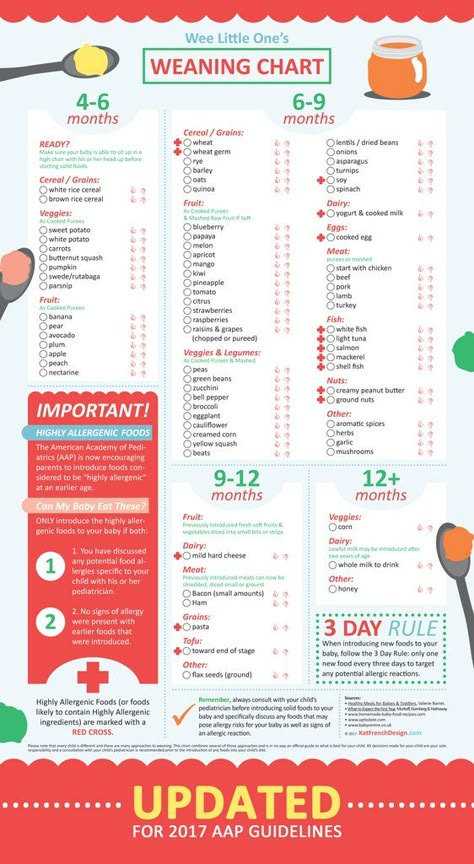
First complementary food
First complementary food – fruits or vegetables and cereals. If parents have doubts about which option is best for a child, you can consult with the observing pediatrician.
Feeding table for breastfeeding:
1. At six months - vegetables, once a day (for example, at lunch). In 1 tsp. zucchini puree add a few drops of vegetable oil, breast milk. A week - up to 60-70 g of complementary foods. After 7 days, it is permissible to introduce cauliflower into the child's diet. From 3 weeks you can supplement baby food with pumpkin.
2. At 7 months - porridge, 1 time per day. Initially, the dish must be made liquid, then the density can be increased.
3. At 8 months - fruits (for breakfast), cottage cheese (for dinner) 1 time per day.
4. At 9 months - meat (addition to vegetables), 1 time per day. The broth cannot be introduced into the diet yet. Give meat in this order: rabbit, turkey, beef. Then you can introduce egg yolk into the diet.
5. At 10 months - fish.
6. After 12 months - milk, juice (natural, not factory-made).
The indicated schedule can be adjusted according to the child's appetite and other factors. Children are allowed to consume water, compote and tea, starting from the first days of the introduction of complementary foods.
It is better to give kefir to newborns at night, but you need to start with a few drops. Gradually, the volume of the fermented milk product should be increased to 100 g.
Rules for the first feeding and advice to mothers
To ensure the full growth and development of the child, it is important to follow the rules for the first feeding:
- Give new foods only from a spoon. So the child will quickly get used to the chewing process, and parents will be able to avoid the problems that arise due to the baby getting used to bottle feeding.
- Use dairy-free cereals. They need to be boiled in water, diluted with mother's milk, which should be expressed immediately before feeding.

- Do not introduce potatoes into the diet of a child under 1.5 years of age. The use of this vegetable should be started only with its preliminary dissolution with mother's milk. This increases the likelihood of assimilation of potatoes, the absence of intestinal colic.
- Start a food diary. Organized records will allow you to track the baby's reaction to a change in nutrition and each new product separately. In the diary, indicate the type, volume of food, the culinary type of its processing. Pediatricians recommend keeping a systematic record from the start of the introduction of complementary foods until the child reaches the age of 1.5 years.
- If children are prone to constipation, the introduction of a large amount of bananas and pears into the diet is contraindicated. With such a feature of the state of the body, it is advisable to use apples, peaches, apricots. They weaken the activity of the intestines, help prevent the development of problems with bowel movements.

- Introduce new products into the diet at intervals of 7 days. This will allow you to track the reaction of the newborn's body to each product separately.
There are no specific restrictions on the use of complementary foods. In one case, the child can eat 50 g, in the other - 150 g. Parents need to focus on the baby's appetite, and not limit the one-time amount of food, since the main goal of expanding the menu is to saturate the growing body.
When planning baby food for breastfeeding by months, you should remember that it should not contain salt, sugar, spices. If the baby refuses to use a new product, although he previously ate it willingly, the best solution is to dilute complementary foods with mother's milk.
As the children's menu expands, it must be taken into account that the nature of the child's stool will change. Since the new diet promotes the activation of the liver, mucus is likely to appear in the stool.
Such a reaction to the first complementary food as reddening of the skin of the face, the appearance of a rash, itching, fever - refers to adverse symptoms.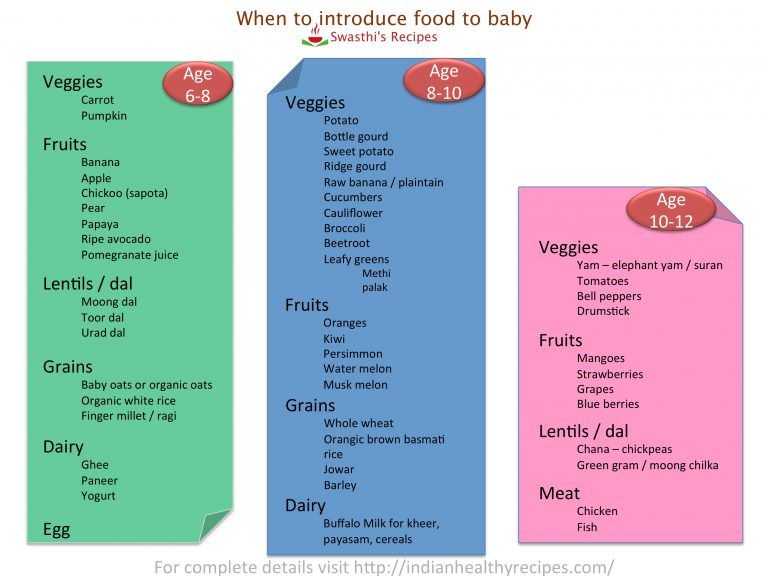 Observing the listed signs, you need to report them to the pediatrician. The specialist will conduct an examination, give recommendations on the replacement of products, and correct the newborn feeding scheme.
Observing the listed signs, you need to report them to the pediatrician. The specialist will conduct an examination, give recommendations on the replacement of products, and correct the newborn feeding scheme.
Complementary foods - what is it and how is it eaten?
home
Articles
Food
Loginevskaya Yana Vladimirovna Pediatrician
24.04.2019
What is weaning and when should we start it? These and many other issues related to child nutrition torment young parents. In the era of the Internet and easy access to information, this information can sometimes become too much.
Let's understand what is complementary foods
Complementary foods is the introduction into the diet of a healthy child at a certain age of any food, home or industrial preparation, that supplements breast milk or food that imitates it, and contributes to the gradual transfer of the child to the general table. As a rule, complementary foods are thicker in consistency than the child's previous food. If the child has any health problems, the introduction of complementary foods may have its own characteristics.
As a rule, complementary foods are thicker in consistency than the child's previous food. If the child has any health problems, the introduction of complementary foods may have its own characteristics.
The purpose of complementary foods in the first year of life is to introduce the baby to foods other than breast milk/or formula. Timely teach to swallow and chew solid food. And also to avoid deficiency of energy and micronutrients, and vitamins.
In the literature and other sources, you can find such names as "pediatric" and "pedagogical" complementary foods?
Pediatric Complementary Food , as its name implies, is a classic complementary feeding regimen recommended by the pediatrician at the appointment. Schemes in which there is a gradual replacement of breast milk / formula feeding with cereals, fruit / vegetable purees and other types of products.
Pedagogical complementary foods - "Pedagogical" means that first of all the child is taught - they are taught to eat, the correct behavior at the table, they teach that food is joy and pleasure, they show new tastes.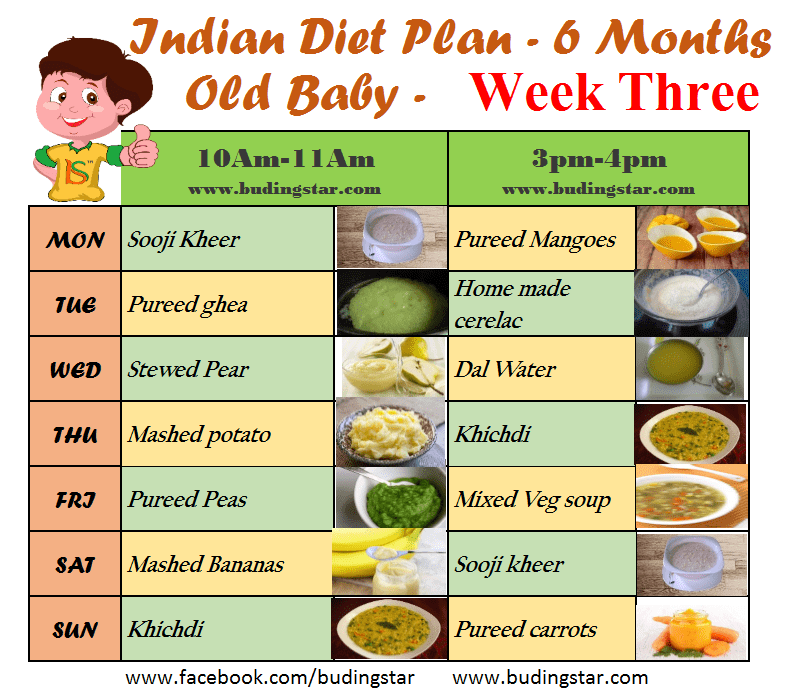 The essence of pedagogical complementary foods is that the child’s nutrition begins with “microdoses” (grains of food) that the child receives from his mother’s plate, nothing is puréed or blended, or even warmed up. Nutrition of the child - together with the family, how much he will eat, he will eat so much. Nothing is specially prepared, the family is invited to switch to a healthy diet. The disadvantage of this type of complementary foods is that the child, starting with “micro doses”, does not adequately increase the volume of complementary foods, which can lead to malnutrition of the child at an older age.
The essence of pedagogical complementary foods is that the child’s nutrition begins with “microdoses” (grains of food) that the child receives from his mother’s plate, nothing is puréed or blended, or even warmed up. Nutrition of the child - together with the family, how much he will eat, he will eat so much. Nothing is specially prepared, the family is invited to switch to a healthy diet. The disadvantage of this type of complementary foods is that the child, starting with “micro doses”, does not adequately increase the volume of complementary foods, which can lead to malnutrition of the child at an older age.
In my article, I will rely on modern research and recommendations primarily from the WHO (World Health Organization) and the National Program for Optimizing the Feeding of Children in the First Year of Life in the Russian Federation.
What requirements must be met in relation to complementary foods:
- Complementary foods must be timely, introduced at the moment when the child's energy and nutrient requirements exceed what can be provided through breastfeeding (or formula).
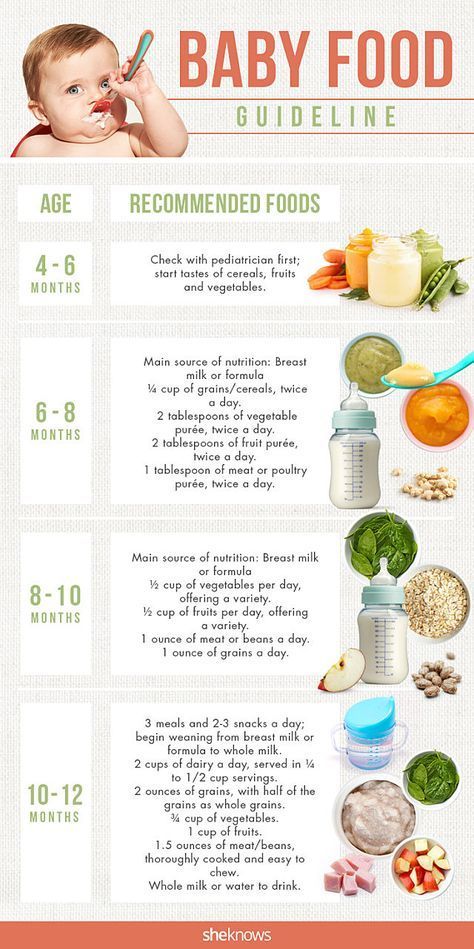
- Complementary foods should be adequate, that is, with enough energy, protein and micronutrients to meet the nutritional needs of a growing child.
- Safe - Store or prepare hygienically and feed with clean hands using clean utensils - spoons, plates, not bottles or teats.
- Properly Administered - The child is fed appropriately for hunger cues, and feeding frequency and feeding methods should be appropriate for the child's age.
When do we introduce complementary foods
The optimal age for the introduction of complementary foods is 6 months.
If the child is premature, then the timing of the introduction of complementary foods is delayed by as much as this child was born earlier (that is, if the child was born not at 40 weeks, but, for example, at 36, we have the right to postpone the introduction of complementary foods for 4 weeks, but if we see that at 6 months the child is already quite ready for the introduction of complementary foods, then you can start as early as 6 months).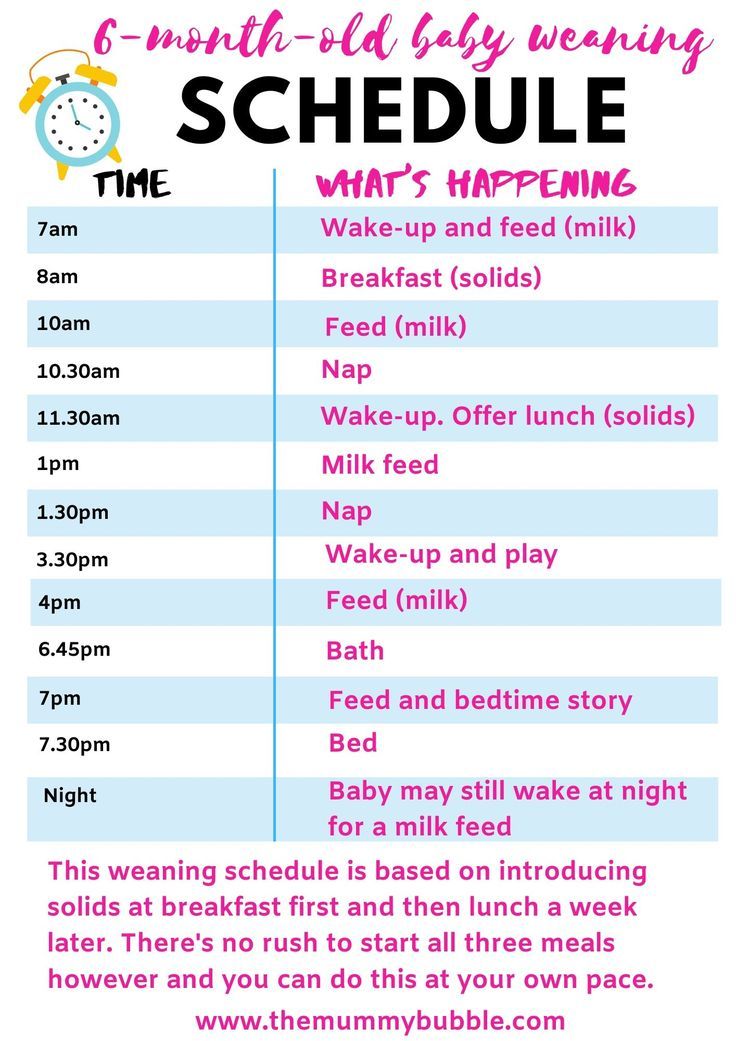 It is advisable to postpone the introduction of complementary foods for no more than 2 months. Try to start the introduction of complementary foods no later than 8 months of the child.
It is advisable to postpone the introduction of complementary foods for no more than 2 months. Try to start the introduction of complementary foods no later than 8 months of the child.
Up to 6 months, breastfeeding fully covers the energy needs of the child. Around 6 months of age, a baby's energy requirements increase dramatically, so it is necessary to add something to his diet in addition to liquid food. Breast milk in terms of its energy value contains 67-68 kcal / 100g, the mixture has approximately the same figures. Breast milk remains a valuable energy product for children not only in the first year of life, but also after a year. At the same time, it should be taken into account that the volume of the child's stomach by 6 months is about 200 ml, so the food introduced to the child must be thicker than formula or breast milk, otherwise we will still not be able to meet the energy needs of the body. The optimal calorie content of complementary foods should be at least 100 kcal / 100 g.
Liquid food and liquid quickly fill the stomach. To fill the energy deficit, it is necessary to introduce foods with a higher energy value than breast milk or formula.
WHO ways to increase calories:
-
cook with less liquid
-
Replace part of the water for cooking with breast milk or a mixture (it must be borne in mind that breast milk contains enzymes (lipase) - which begin the digestion and breakdown of food even before it enters the child's body, so instant cereals, when breast milk is added, immediately become liquid, but their energy value is not lost.
What do we focus on when introducing complementary foods:
The main criterion is the readiness of the child to introduce complementary foods - the child shows interest in food, the so-called food interest - he is interested in what his mother eats, actively reaches for food from his parents' plate, wants to taste it.
Indirect criteria
- Child's age about 6 months
- Decreased ejection reflex of solid food (active interest in food never appears until ejection reflex fades)
- Doubling birth weight (optional item, some babies double their weight before 6 months of age)
- Child can sit with support
- The first teeth appear in a child (again, not always)
Principles of maintaining interest in food
- Parents should remember that in order to form the main criterion for readiness for complementary foods, the child must see how his family eats.
 The formation of eating habits comes from the family and the immediate environment of the child. If, before 6 months, the child has never seen how mom or dad eats, how they eat at the table and what they eat, he may not have a food interest by 6 months. Food interest begins to gradually form as a skill of tracking the actions of an adult from 3 months of age. That is, somewhere from the age of 3 months the child, if you take him with you to the kitchen (dining room), the child begins to observe the process of eating, and gradually this interest - from the interest of "observation" goes to the "desire" to try just like mom or dad.
The formation of eating habits comes from the family and the immediate environment of the child. If, before 6 months, the child has never seen how mom or dad eats, how they eat at the table and what they eat, he may not have a food interest by 6 months. Food interest begins to gradually form as a skill of tracking the actions of an adult from 3 months of age. That is, somewhere from the age of 3 months the child, if you take him with you to the kitchen (dining room), the child begins to observe the process of eating, and gradually this interest - from the interest of "observation" goes to the "desire" to try just like mom or dad. - It is advisable not to feed the baby separately and try to eat with the baby what the baby eats. If you are feeding your child with industrial food (ready-made mashed potatoes in a jar), then try this food with your child. Try to bring the canned food as close as possible to the general view on the table - transfer the puree from the can to a plate, give a spoon.
 At the age of 8-10 months, the child learns to eat with his hands, so at this age it is advisable that the child has small pieces of food on the plate that he already eats - these can be pieces of boiled potatoes, broccoli, cauliflower, pieces of apple, banana. The pieces should be small, 1 x 1 cm, so that the child can grab them with his fingers. In parallel, the mother can supplement the child from the plate with the main food. The child learns to cope with more solid food, learns to chew, swallow. The sooner the skill of swallowing more solid food is worked out, the easier it is for parents in the future. At the age of 10-12 months, the child's fine motor skills are already improving, he is learning to eat with a spoon (be patient, different children do it in different ways and at different speeds)
At the age of 8-10 months, the child learns to eat with his hands, so at this age it is advisable that the child has small pieces of food on the plate that he already eats - these can be pieces of boiled potatoes, broccoli, cauliflower, pieces of apple, banana. The pieces should be small, 1 x 1 cm, so that the child can grab them with his fingers. In parallel, the mother can supplement the child from the plate with the main food. The child learns to cope with more solid food, learns to chew, swallow. The sooner the skill of swallowing more solid food is worked out, the easier it is for parents in the future. At the age of 10-12 months, the child's fine motor skills are already improving, he is learning to eat with a spoon (be patient, different children do it in different ways and at different speeds) - Be mindful of the child's physical condition - do not introduce new foods when the child is unwell or tired or teething or has undergone some medical procedure such as a vaccination
- Offer small portions.
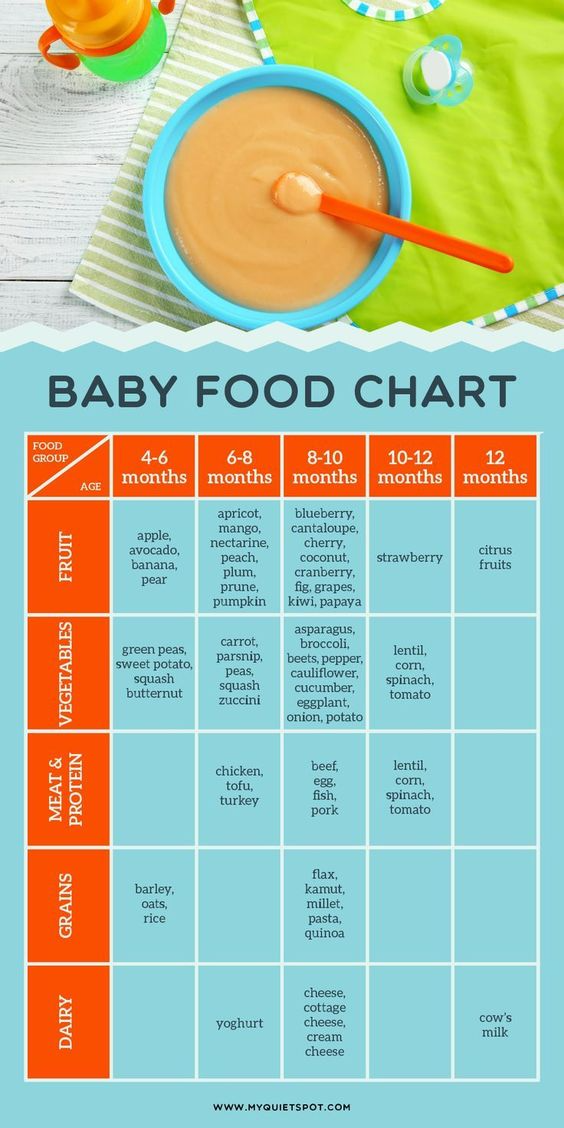 Some children undereat food because they are initially intimidated by the portion size. Do not insist that the child finishes the portion. Let it be better after some time to ask for another
Some children undereat food because they are initially intimidated by the portion size. Do not insist that the child finishes the portion. Let it be better after some time to ask for another - Try to keep the area around the child clean! This initially teaches the child to cleanliness at the table and to a neat diet. Some children are very sensitive to external stimuli - dirty hands, face, clothes can cause them severe discomfort
- Help the child if you see that the child is "interested" in food, but tired of fighting with it.
- No games, entertainment or persuasion while eating - in this way you replace food interest with interest in the game. The child will not be able to learn to adequately assess their desires in food. Don't turn food into a show.
Complementary feeding rules:
-
any new product is introduced only to a healthy child. A breastfed baby is given complementary foods up to the breast.
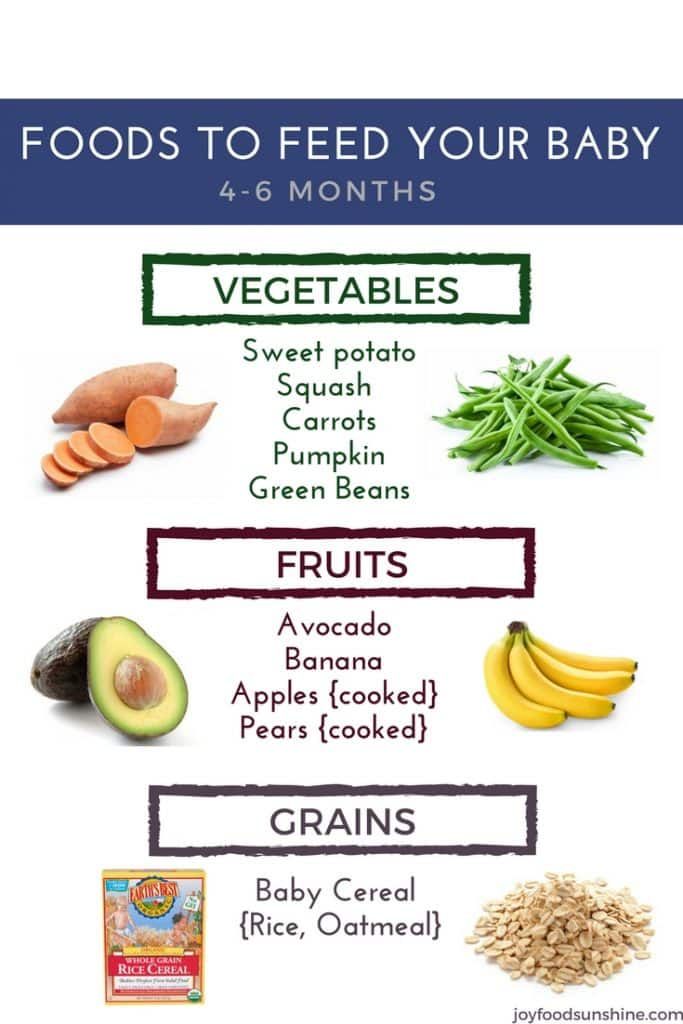
-
the introduction of new foods should not coincide with vaccinations, teething, vacations, or other stress for the child (when stressed, the child may refuse the proposed new product).
-
any new product is introduced in the morning (so parents have time to observe the child, look at his reaction, notice allergic manifestations) If the child has a reaction to a new product, then it is better to write it down, and try to introduce the product again after 5- 10 days. Because this reaction may not be related to the product, but caused by other factors. If the negative reaction is repeated, then the introduction of this product is postponed for 3 months.
-
it is advisable to introduce no more than one new product per day.
-
to get acquainted with the product, the child sometimes needs 10-15 sentences in order for him to start eating it. The reaction of the child in the form of wrinkling, pushing food, curvature of the face does not indicate that the child did not like the food, but only that the new taste is very bright for him and causes a large number of emotions.
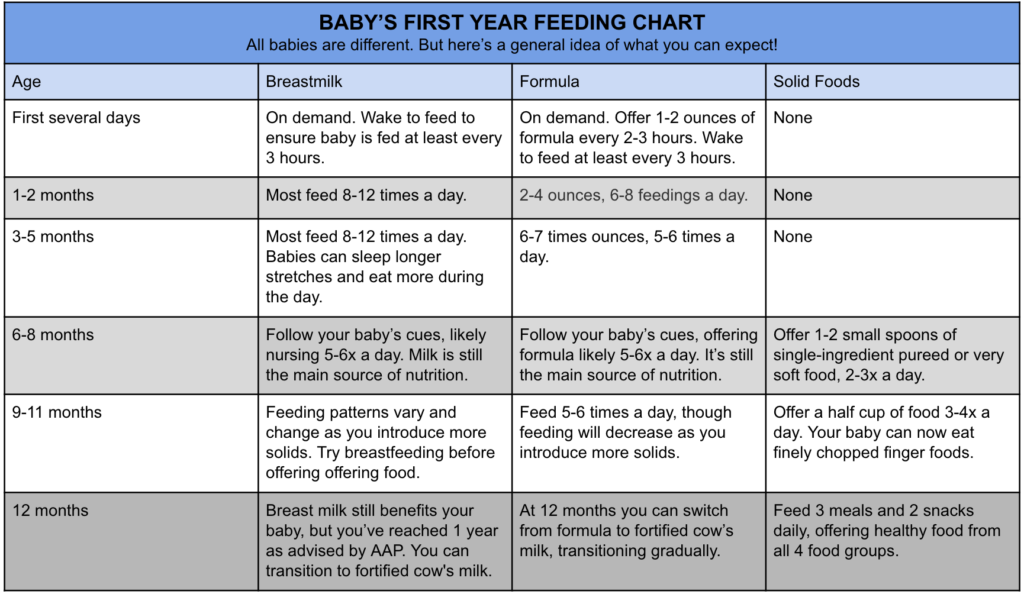 For children, even neutral tastes can seem very rich, due to the higher sensitivity of the receptors. Therefore, when introductory feeding, it is not recommended to use spices and salt in the preparation of food for the child.
For children, even neutral tastes can seem very rich, due to the higher sensitivity of the receptors. Therefore, when introductory feeding, it is not recommended to use spices and salt in the preparation of food for the child.
Basic complementary foods
For the first feeding, there are three main types of products: cereals, vegetables and meat.
-
Cereals - Dairy-free cereals are used to start complementary foods. Rice, corn, buckwheat are the first to be introduced - these can be special “instant” baby cereals (we carefully study the composition, make sure that there are no additives, sweeteners, flavor enhancers, vitamins), instant cereals are well suited to start complementary foods, at 6-7 months, in the future you can switch to ordinary "adult" cereals, you can grind ready-made buckwheat or rice with a blender or fork; instant porridges in the form of flakes are also good. Then the rest of the cereals (oatmeal, rye, millet) are introduced.
 With an allergic burden in the family, the introduction of milk porridges earlier than 12 months is not recommended.
With an allergic burden in the family, the introduction of milk porridges earlier than 12 months is not recommended. -
Vegetables – first we introduce green/white vegetables (zucchini, cucumber, broccoli, kohlrabi, cabbage and cauliflower), then legumes, colored vegetables (carrots, pumpkin, beets, tomato)
-
Meat - the beginning of complementary foods with the most easily digestible and hypoallergenic meats - rabbit, turkey, then veal, beef, pork, lamb. Children with an allergy to cow's milk protein start complementary foods first with pork, then they introduce beef. Children with allergies are also trying to limit the introduction of chicken into the diet, as it is a highly allergenic product. Lamb is introduced to children no earlier than 10 months. Poultry meat - duck, goose - contains refractory fats and is not recommended for introduction into the diet of babies under 3 years of age.
-
Fruit and dairy products are not considered essential complementary foods.
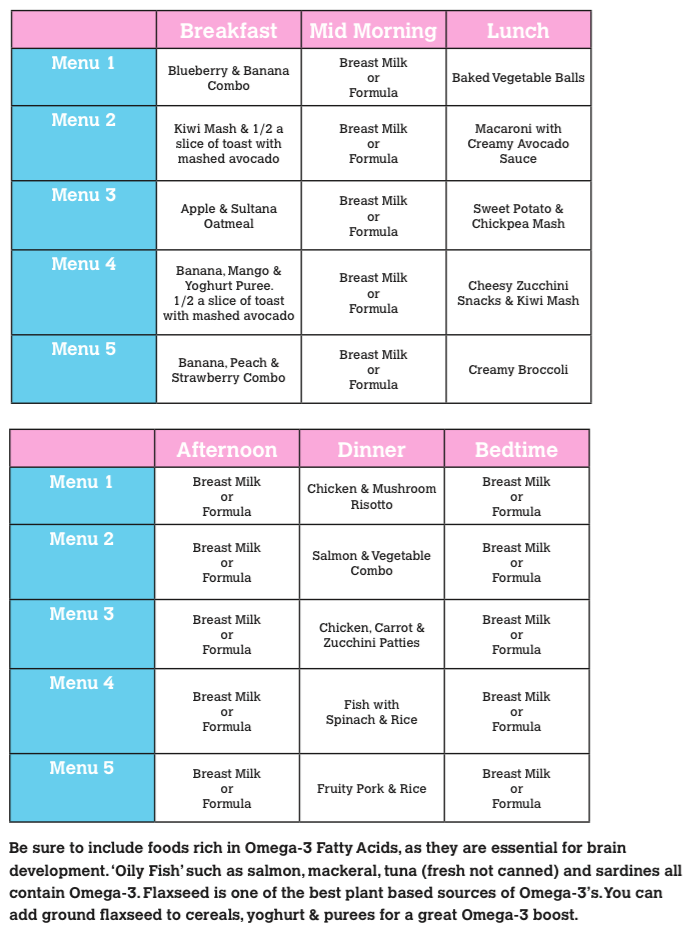 Can be given for table variety. If the mother wants to give fruits, berries and juices to the child, it is better to use them as a flavoring additive to the main complementary foods or even postpone the introduction to an older age. In children with an allergic tendency, it is recommended not to introduce dairy products up to a year. You have to be careful with berries and fruits. It is best to start complementary foods with seasonal fruits and berries; the least and least likely to cause allergies are currants, blueberries, apples, pears, plums. Allergic reactions often occur on strawberries, bananas, citrus fruits.
Can be given for table variety. If the mother wants to give fruits, berries and juices to the child, it is better to use them as a flavoring additive to the main complementary foods or even postpone the introduction to an older age. In children with an allergic tendency, it is recommended not to introduce dairy products up to a year. You have to be careful with berries and fruits. It is best to start complementary foods with seasonal fruits and berries; the least and least likely to cause allergies are currants, blueberries, apples, pears, plums. Allergic reactions often occur on strawberries, bananas, citrus fruits. -
Fish and seafood. Not a staple complementary food. But fish, like meat, is a source of protein, rich in polyunsaturated fatty acids, as well as minerals and vitamins. It is recommended to introduce fish no earlier than 9-10 months. Again, if the child is allergic, it is advisable to refrain from introducing fish products up to 1 year. We begin to introduce complementary foods with low-fat white varieties of fish in the form of mashed potatoes - ice fish, hake, cod, haddock, pollock, navaga, pike perch, sea bass, dorado.

-
Egg . A product that is rich in many different micro and macro elements, vitamins. However, the egg has a very high allergenicity (included in the very big eight allergens). Considering that a quarter (5-6 g) or half (10-12 g) of the yolk, which are recommended to be administered, contains very few nutrients and energy, it is easier not to give this product than to risk allergic reactions in a child.
-
Whole nuts, peanuts Should not be present in a child's diet until at least three years of age. In a number of countries, communities, families, where, for example, peanuts are common as a staple food, they can be used as an additive to complementary foods in a pureed state. Nuts are included in the big eight allergens and are not recommended for introduction into complementary foods for children with allergies up to three years of age.
-
Water . After the introduction of complementary foods, children can begin to offer water as a drink.
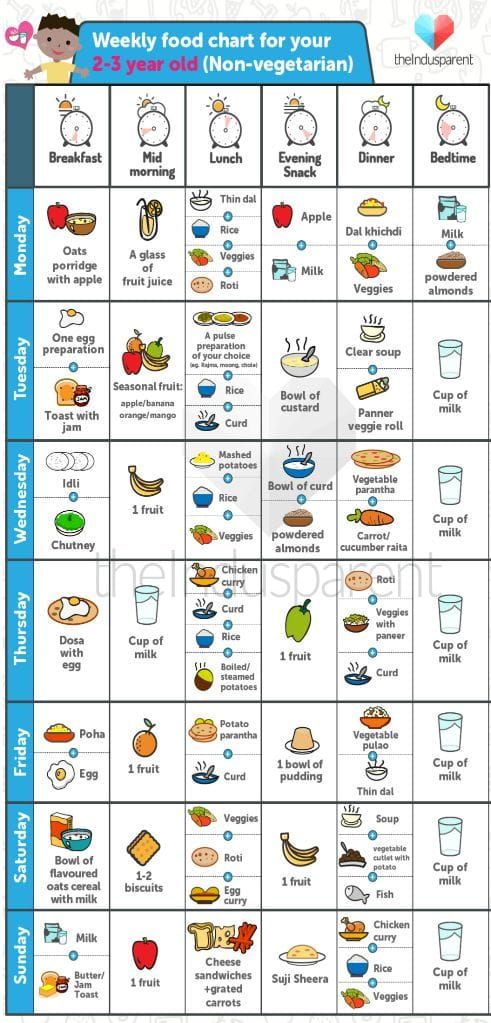 First as an introduction, later as an additional source of fluid, while reducing the volume of breast milk (mixture). It should be pure water without any additives. It is important to remember that breastfed babies may go without water for quite a long time, due to the fact that they receive enough liquid from breast milk.
First as an introduction, later as an additional source of fluid, while reducing the volume of breast milk (mixture). It should be pure water without any additives. It is important to remember that breastfed babies may go without water for quite a long time, due to the fact that they receive enough liquid from breast milk. -
Tea . The World Health Organization does not recommend including tea in the diet of children under 2 years of age. Why? First of all, because of the tannins that are present in tea and can help reduce the absorption of trace elements, including iron and cause anemia. Tea also contains caffeine (it is found in a state associated with tannins and is more often called theine), which can cause excessive stimulating effect on the fragile nervous system of the child., It can also lead to increased heart rate, increased peristalsis of the stomach, increased body temperature - all this can adversely affect the general condition of the child.
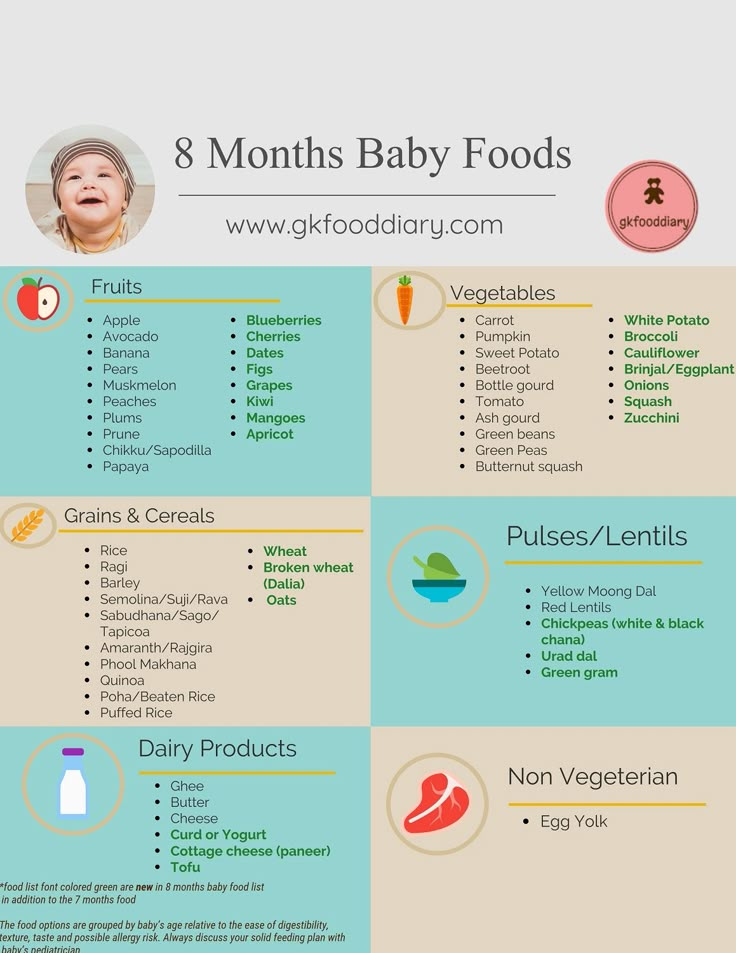
Learn more

